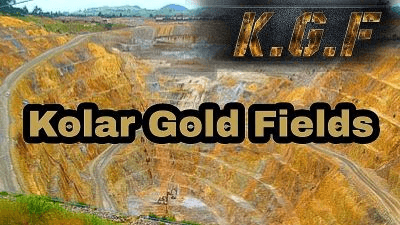KGT stands for Kolar Gold Fields. It is a gold mining area located at the Bangarpet taluk in the Kolar District of Karnataka, India. It was one of the major gold mines in India, which was closed in 2001 due to increased production costs, reducing deposits and low gold production.

Interesting facts about KGF
Certainly! Here are the key facts about the Kolar Gold Fields (KGF) in India in a shortened form:
- Historic Gold Mines in Karnataka, India.
- British Colonial Era Mining.
- Deep Mines – Champion Reef Mine reached 3 km.
- Major Gold Producer in the Early 20th Century.
- Popularized by the Indian Film “KGF: Chapter 1”.
- Closed in 2001 Due to Depleted Reserves.
- Environmental Challenges Post Closure.
- Attracts Tourists Interested in Mining History.
- Geological Significance in Gold-bearing Formations.
- Economic Impact on Local Economy Post Closure.
Mining Operations of KGF
- Mining operations on the Kolar Gold Fields (KGF) have been an extensive part of India’s mining history. Here’s an outline of those operations in human-written shape:
- The Kolar Gold Fields (KGF) had been home to vast and historically vast mining operations in the kingdom of Karnataka, India. These operations, which started below British colonial rule in the 19th century, have been ordinarily centred on extracting gold from deep underground mines.
- One of the standout functions of KGF mining was its incredible intensity. The Champion Reef Mine, one of the maximum famed mines at KGF, delved to depths exceeding 3 kilometres, making it one of the private mines globally. This depth underscored the super engineering and logistical challenges confronted by miners.
- During its height in the early 20th century, KGF performed a pivotal position as one of the world’s foremost gold producers. It contributed extensively to India’s gold output and brought enormous wealth to the British Empire. The tremendous scale and productivity of the KGF mining operations have been instrumental in its international reputation.
Decline of KGF
The decline of Kolar Gold Fields (KGF) can be summarized as follows:
- Depleted Gold Reserves: Gold reserves were exhausted after extensive mining.
- Rising Costs: Deep mining led to unsustainable operational expenses.
- Environmental Issues: Legacy of environmental challenges, including subsidence and pollution.
- Technological Constraints: Slow adoption of innovations to improve mining efficiency.
- Labour and Social Problems: Labor disputes and safety concerns disrupted operations.
- Market Fluctuations: Global gold price instability affected profitability.
- Infrastructure Abandonment: After closure in 2001, infrastructure was neglected.
- Economic Diversification: Efforts were made to diversify the local economy.
KGF, once a symbol of wealth, has transitioned into a historically and geologically significant region with a focus on environmental remediation and tourism.
Environmental and Social Issues
Environmental and social issues can be summarized as follows:
Environmental Issues:
- Climate Change: Resulting from increased greenhouse gas emissions, causing temperature rise and extreme weather.
- Biodiversity Loss: Habitats are disappearing, leading to species extinction.
- Deforestation: Clearing forests for agriculture and development, impacting biodiversity and climate.
- Air Pollution: Emissions harm air quality and human health.
- Water Pollution: Contaminants harm aquatic life and human health.
- Resource Depletion: Overuse of minerals, fisheries, and freshwater.
- Waste Management: Poor disposal leads to pollution and health risks.
- Habitat Destruction: Urbanization disrupts natural habitats.
Social Issues:
- Poverty: Millions lack basic necessities like food, clean water, education, and healthcare.
- Inequality: Economic, gender, racial, and social disparities persist.
- Healthcare Access: Unequal access contributes to disease and premature death.
- Education Gaps: Unequal educational opportunities perpetuate disparities.
- Hunger and Malnutrition: Despite global food production, many suffer.
- Conflict and Violence: Ongoing conflicts displace populations and hinder development.
- Human Rights: Discrimination, oppression, and exploitation persist.
- Migration and Displacement: Forced migration strains resources and communities.
- Water and Sanitation: Lack of access poses health risks.
- Child Labor and Exploitation: Child labour and trafficking remain challenges.
Conclusion
In conclusion, the Kolar Gold Fields (KGF) represent a historical, cultural, and geological treasure with a complex and multifaceted story. Once a global symbol of wealth and prosperity due to its gold mining operations, KGF faced a gradual decline that led to the cessation of mining activities in 2001. This decline was driven by factors such as depleted gold reserves, rising operational costs, environmental challenges, technological limitations, labour disputes, and global gold market fluctuations.
FAQ's About KGF
KGF, short for Kolar Gold Fields, is a region in the state of Karnataka, India, known for its historical gold mining operations.
Gold mining in KGF dates back to ancient times, but modern mining operations, particularly under British colonial rule, started in the 19th century.
No, KGF is no longer an active gold mining area. The mines were closed in 2001 due to depleted gold reserves and high operational costs.
The KGF mines were known for their incredible depth. The Champion Reef Mine, one of the deepest, reached a depth of over 3 kilometers (nearly 2 miles).
Related posts:
- AMC Full Form: Benefits, Components, Needs, Advantage
- ORS Full Form: Dehydration, Myths, Flavors, Varieties & Facts
- PCC Full Form: Importance, Types, Application Process
- PAN Full Form: Legal Provisions, Regulations,
- BRB Full Form: Productive, Routine, Distractions
- MCD Full From: Introduction, Responsibility, Challenges
- CT Scan Full Form: Scans, price, Advantages
- USA Full Form: History, Economics,Technology, culture




















